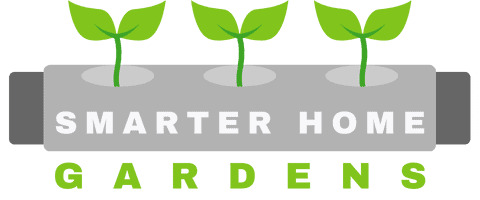This article contains affiliate links. As an Amazon Associate, SmarterHomeGardens.com earns a small commission on qualifying purchases at no extra cost to you.
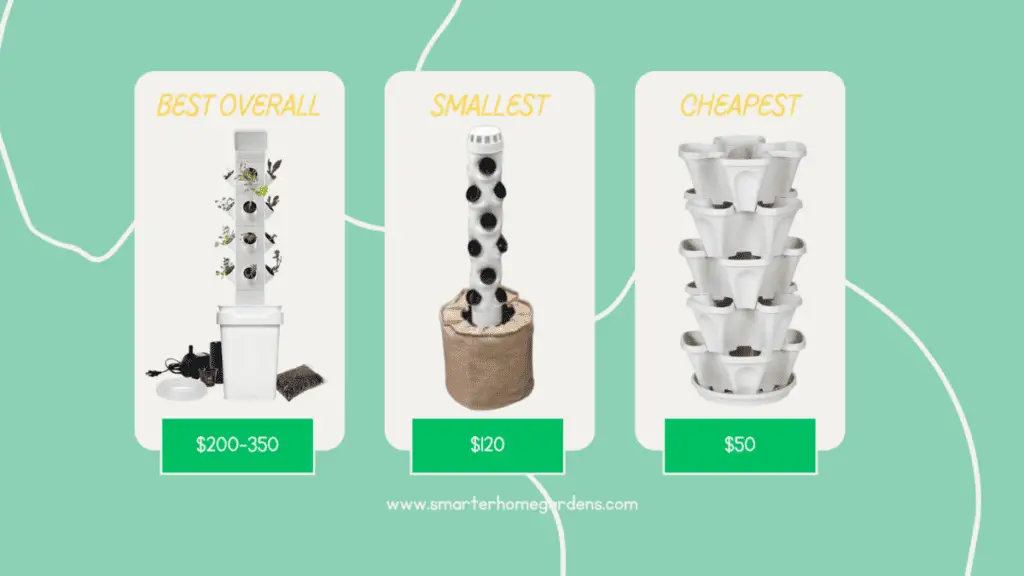
In today’s urban environment, space is often at a premium. If you’re like me and living in a small apartment, you may be forced to seek innovative solutions for indoor gardening. Enter the hydroponic tower system, a game-changer for those wanting to maximize yield within a minimal footprint.
Vertical hydroponic towers are among the most space-efficient hydroponics systems on the market, combining excellent plant capacity with a small footprint to fit in just about any small indoor space.
In this article, we’ll delve into the top hydroponic tower systems tailored for small indoor settings, helping you make the most of every square inch you have. Let’s dive right in!
Why Choose a Vertical Hydroponic Tower System?
There are many advantages to vertical hydroponic tower systems. Personally, I find them some of the best overall hydroponics systems on the market.
You’ve heard of a ‘vertical farm’, right? There’s a reason why commercial growers prefer hydroponic towers over other types of hydroponic systems.

Top tip: Read my article ‘How efficient are vertical hydroponic towers?‘
Here are a few reasons why you should consider buying a hydroponic tower:
- They’re among the most space-efficient hydroponic systems out there
- They are among the most water-efficient hydroponics systems
- They have a large plant capacity
- They’re low maintenance and easy to set up
- They’re perfect for beginner hobby growers
- They can easily be moved (indoors and out)
- They look cool!
Key Criteria to Consider
Before diving into my top picks, it’s essential to understand the criteria I’ve based my selections upon. These considerations are born from both personal trials and insights from the hydroponics community.
Let’s break down what I’ll be evaluating these systems on, ensuring you get the most value and functionality out of your choice.
1. Size and footprint
One of the key determining factors is the overall footprint of the system (that is to say, the total amount of space it takes up). The more compact the system, the better it’ll be for small, indoor spaces.
2. Capacity
Another consideration is the number of plants the vertical tower can accommodate. It’s essential to find a balance where you can cultivate a variety of plants without the tower overwhelming your space due to its size.
3. Lighting
Lighting is crucial for indoor systems. Therefore, determining if a vertical hydroponic tower includes integrated lighting, or if you’ll need to provide it separately, is a vital factor in making your choice.
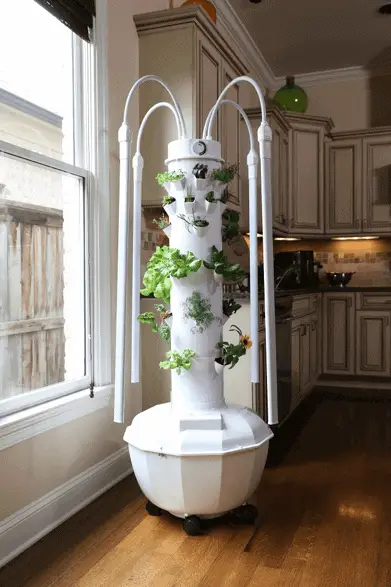
4. Price
And finally, price. Hydroponic tower systems are among the most expensive systems to build or purchase, so doing your research and selecting a system that meets your budget is essential.
Top Small Hydroponics Systems for Small Indoor Spaces
Over the years, I’ve witnessed firsthand the challenges of urban gardening in compact spaces.
From my personal experiences and thorough research, I’ve curated this list of the top small vertical hydroponics systems that have impressed me with their functionality and thoughtful design for tight spaces.
Let’s dive in.
1. BEST OVERALL: EXO Garden Hydroponic Growing System Vertical Tower
Optimize your limited space with this hydroponic system tailored for apartments and compact settings.

Product details
The EXO Garden wins ‘best overall’ vertical hydroponic garden for small, indoor spaces because of its compact design, value for money, and ample growing capacity.
- Size & footprint: The EXO hydroponic growing system is designed to efficiently utilize as little as two square feet with a footprint of 42x13x13 inches. Perfectly sized for tight spaces.
- Capacity: Despite its modest size, the tower boasts a good maximum plant capacity of 24. Smaller versions are available, starting from as little as 12 plants, great if you want an even smaller setup.
- Lighting: The EXO hydroponics system doesn’t include lights.
- Price: While the EXO isn’t the cheapest system on this list, it is arguably the best value. Prices start at around $200 for the 12-plant system and go up to around $350 for the 24-plant system.
| Pros | Cons |
|---|---|
| Modular design | Indoor only |
| Very easy to clean | Requires additional lighting kit |
| Large plant capacity | Not as high-yield |
2. BEST FOR BEGINNERS: Vertical Horizons 18 Plant Capacity Tower
Handcrafted hydroponic aeroponic/drip system, meticulously made by hand instead of 3D printing, offering an organic look and improved water flow.
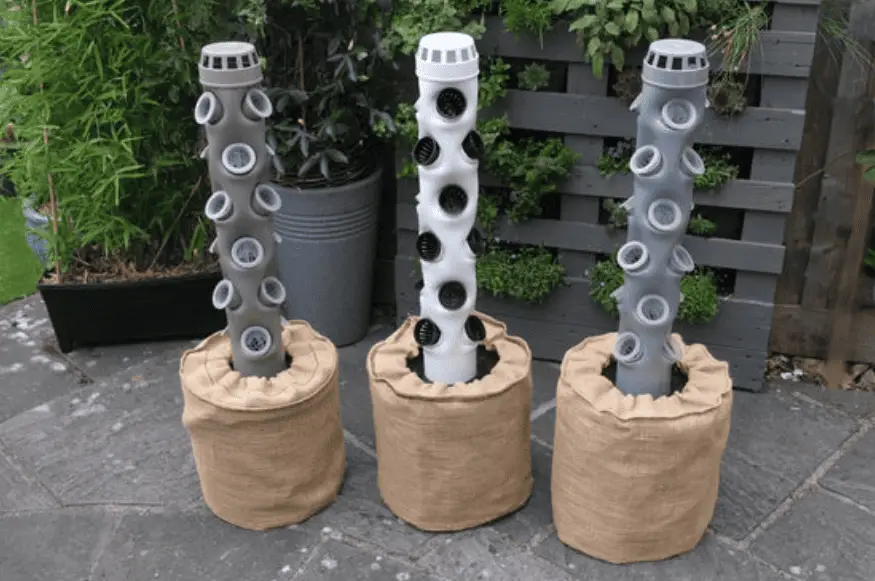
Product details
I really like these hydroponic towers. In fact, I have two of them myself!
This system is designed to offer an economical entry into hydroponics while delivering excellent yields. Its compact design and vertical orientation enable year-round cultivation, perfect for those lacking garden space.
- Size & footprint: The 1m Vertical Horizon hydroponic growing system has one of the smallest footprints on the market at just 40 x 13 x 13 inches, which makes it a great system to place almost anywhere in or outside your home.
- Capacity: The smallest tower (1m) holds 18 plants, which is respectable. However, they make bigger domestic systems that can hold up to 35. And, there’s a commercial system that holds up to 45.
- Lighting: Only the larger commercial-grade tower from Vertical Horizons comes with lights built in.
- Price: Their smallest and most compact system starts at $120 with their commercial system going up to just over $300. You get a lot of bang for your buck though and the construction quality is exceptional.
Check out Vertial Horizons. They’re awesome.
Key specs:
- Water System: Efficient pump and distribution with a 1-watt power supply, complemented by a water filter.
- Reservoir: 20L bucket, crafted from food-safe materials.
- Plant Support: Includes net cups, plant support pucks, and pebbles for supporting the roots of young plants.
- Nutrients: 200ml of premium, all-natural, vegan, and organic nutrients, sufficient for 4-5 months.
- Timer: Mechanical timer equipped with a UK plug.
- Seed Starter Kit: Comes with 60 seeds, a propagator, and 54 Rockwool cubes.
- Materials: Built from UV-stabilised components, free of phthalates and BPA.
| Pros | Cons |
|---|---|
| Incredible value | Limited shipping destinations |
| Three stylish colors + hessian sack option | Smaller systems require lights |
| Multiple sizes to choose from | Not a modular system, harder to clean |
3. BEST PREMIUM SYSTEM: Tower Garden Home (with lights)
The “Tower Garden HOME with lights” provides numerous planting slots, integrated wheels, and distinctive attributes to make healthy and pure food consumption easier than ever.
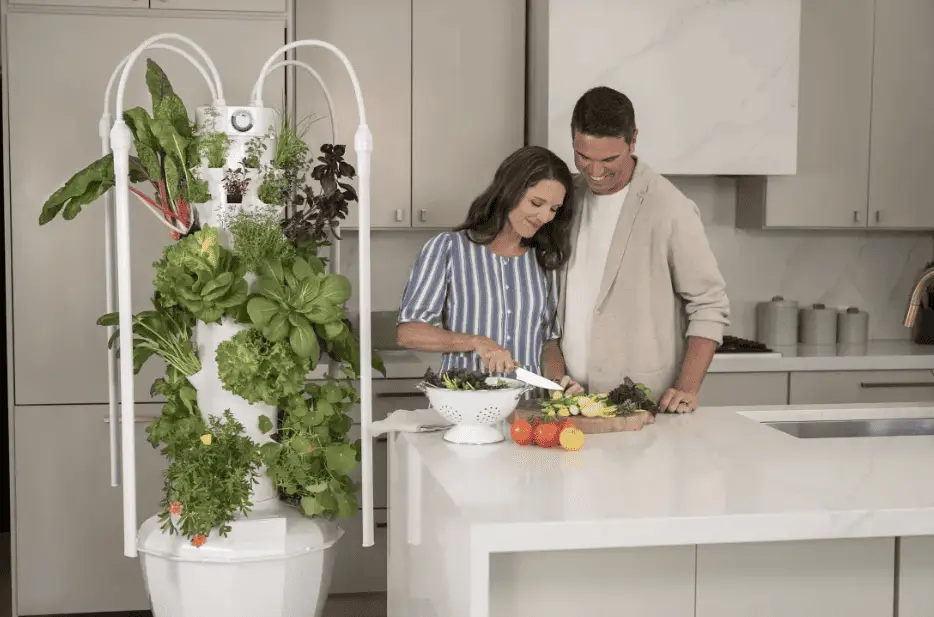
Product details
The Tower Garden Home is a vertical, aeroponic system that can accommodate up to 32 plants and comes with a comprehensive set of helpful add-ons, from seedling starter kits to LED lights. It’s a premium system, so it’s very well-built and the inclusion of wheels provides additional mobility.
- Size & footprint: The Tower Garden Home is the biggest vertical hydroponics system on this list – by far. Depending on how much space you have, it may not be appropriate to keep indoors. Its dimensions are: 58″x 23″ x 23″ inches / 148 x 59 x 59 cm.
- Capacity: The Tower Garden Home has a maximum plant capacity of 32, split with 16 larger pockets (for more mature plants) and 16 smaller pockets (for young or smaller plants).
- Lighting: The ‘Home’ model comes with three dangling LED lights. The lights come with a three-year warranty which is a nice bonus.
- Price: Tower Garden has a range of systems at different price points. The premium system, the ‘Home’ model, comes with lights and costs around $1000.
| Pros | Cons |
|---|---|
| 5-year warranty | Pretty expensive |
| Comes with lights | It’s quite large |
| Large plant capacity | Heavy |
4. BEST FOR LOW BUDGETS: Mr. Stacky 5 Tier Planter
Mr. Stacky is a firm favorite among vertical gardeners for its flexibility, cheap price, and ease of use. While not technically a hydroponic system, it deserves an honorary spot on this list.

While not technically a hydroponic system, the Mr. Stacky Planter offers a space-efficient, five-tier stackable design perfect for small spaces, accommodating up to 20 plants. So it’s worth mentioning here.
Its budget-friendly price point and versatile planting options make it an ideal choice for indoor gardening enthusiasts starting their hydroponic journey.
- Size & footprint: The Mr. Stacky Planter is perfect for small spaces. Its vertical, five-tier stackable design allows for efficient use of space, while each food-safe polypropylene planter boasts a 12-inch diameter.
- Capacity: Though it’s compact, it doesn’t compromise on capacity; you can accommodate up to 20 plants, making it ideal for those limited by space but not ambition.
- Lighting: The Mr. Stacky vertical planter doesn’t come with any lights.
- Price: It’s the cheapest system on this list at under $40. Bargain!
Tips for Successful Vertical Hydroponic Growing
The world of hydroponics can be overwhelming at first. I know that I found it to be so when I first started out. A few years in, I now count myself as a seasoned expert (not really but I’m ok!).
There are lots of things that can go wrong in hydroponics. In fact, I’ve listed 19 of the most common problems in another post.
Knowing what I do now, here’s what I’d recommend for those looking for some advice and success criteria:
- Educate Yourself: Read as much as you can. My website can help you, but there are plenty of resources out there to help you get started. Different plants have different nutrient, light, and care requirements. Research the specific needs of the plants you’re growing and don’t make it up!
- Regular Maintenance: Don’t underestimate the importance of cleaning the system periodically to prevent algae growth and blockages. Check pumps, timers, and other equipment to make sure they’re working correctly.
- Lighting: Light is so important, especially for indoor systems. Ensure your plants receive adequate light. If growing indoors, use high-quality grow lights. Outdoors, place the tower where it can receive at least 8-10 hours of sunlight daily
- Choose the right plants: Hydroponic towers are great for growing a range of different plants but some are better than others. I’ve written about the best plants to grow in a hydroponic tower.
- Experiment: Hydroponics unlocks a world of possibilities. Have fun with it and don’t be afraid to make some bold decisions and take some risks!
Summary
Hydroponic towers are specifically designed with a compact footprint, making them ideal for environments where space is a concern.
Their vertical structure efficiently maximizes growth potential in a minimal area, rendering them particularly suitable for tight spaces such as small gardens, patios, or indoor rooms.
The convenience of these systems lies in their ability to transform even the smallest of spaces into productive growing areas.
For those prioritizing space efficiency without compromising on cultivation capability, hydroponic towers offer a streamlined and practical solution.
